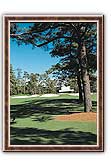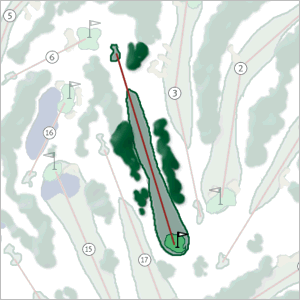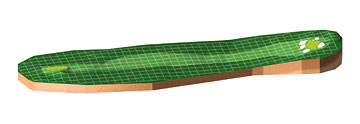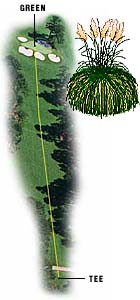| Hole Names | |
|
|
|

Hole #7PampasCortaderia selloana Par 4, 365 Yards |

|
||
|
The first shot on this hole is often played to the left center of the fairway into a slight upslope. From there a short iron may be played, but it is important to avoid the three bunkers in front of the green and the two behind. One of Augusta National's tightest fairways. Approach is uphill to small, elevated green surrounded by bunkers. One of Augusta National's tightest fairways. Approach is uphill to small, elevated green guarded by three deep bunkers in the front and two bunkers in the back. Very tight both in fairway and green, which is surrounded by sand as is no other hole at the National. The green is small and difficult to hold. | |||

QuickTime AVI (3.97M) Animated GIF | |||
|
Jack Nicklaus says: Three-wood or 1-iron off the tee to play a full wedge into the green. Here a nice, soft lofted shot, hit the right distance, is the real key, obviously. When I first played here, there were no trees on the left side of the seventh fairway. Now, there is nothing but trees. The seventh hole has gone from one of the more open short holes to one of the tightest little holes youíve ever seen. It might appear from the yardage that players have the opportunity to take a breather here after three tough holes, but if you let down for a second, you can post a big number. You need an accurate tee shot with a driver, 3-wood or 1-iron, depending on what you feel comfortable with. This will leave you a short second shot to a very narrow green. Like the third hole, selecting the right club and hitting it the proper distance are key factors here. When the flagstick is on the right, I shoot directly at it. Otherwise, I aim for the gap between the bunkers behind the green. That way, if I hit the ball a little strong, Iím only on the back fringe and I can putt back down. Generally, I feel as though my second shot should be close to the hole. This is one of the great little short holes in golf. Anytime you can walk away with a birdie, you feel youíve gained a stroke on the field. Fuzzy Zoeller says: This is one of my favorite holes. It proves you don't have to have a long hole to be a great hole. The second shot is straight uphille with either an 8 or 9 iron or a wedge. The green is well bunkered with a ridge in the middle. This is just a classy little hole. Tiger Woods says: The narrowest hole on the course. You'll see guys hit irons or fairway woods, leaving themselves a sand wedge or 9-iron to a green that has two distinct areas to hit to: a bottom-right bowl, and a top-left shelf. There are four bunkers that guard that green, and you have to be very careful to hit the ball the right distance. Fred Couples says: It's a very, very short hole. I've always tried to play with a driver or a 2-iron all depending how I feel. If you hit a driver you can get it all the way down there and have a sand wedge to the green. Bernhard Langer says: There are two things I think about when someone mentions the seventh hole at Augusta: a tight tee shot and a very severe green. But both Sam Snead and Larry Mize birdied all four rounds here in 1957 and 1994, respectively, so it offers a nice opportunity to gain ground. The seventh hole is somewhat similar to the third, but I think if your tee shot is in good shape, it's a little easier. The difficulty here is hitting the tee shot straight because you're driving through a narrow chute of trees left and right. If you can get the ball out there about 240 to 250 yards, you'll find yourself on an upslope, a perfect place from which to hit your approach to the green. In that ideal position, you can see only the top half of the flag and the sand is intimidating. The front bunkers aren't easy to get out of because they're very deep. You don't want to go long, because you have no shot from either of the two back bunkers. I usually hit a 3- or 5-wood to leave me a full approach using a wedge or 9-iron. I try to hit to the half of the green where the flagstick is positioned and spin the ball to get it on the correct side of the hole.
| |||

Hole #7PampasCortaderia selloana The hole is named for its distinctive pampas grass, Cortaderia selloana. Native to Argentina, it sends up its plume-like flowers in August, the seed tassels lasting until spring. |

|
||
fatpat Software · PO Box 1785 · Charlottesville, VA 22902 · (804) 977-1652
